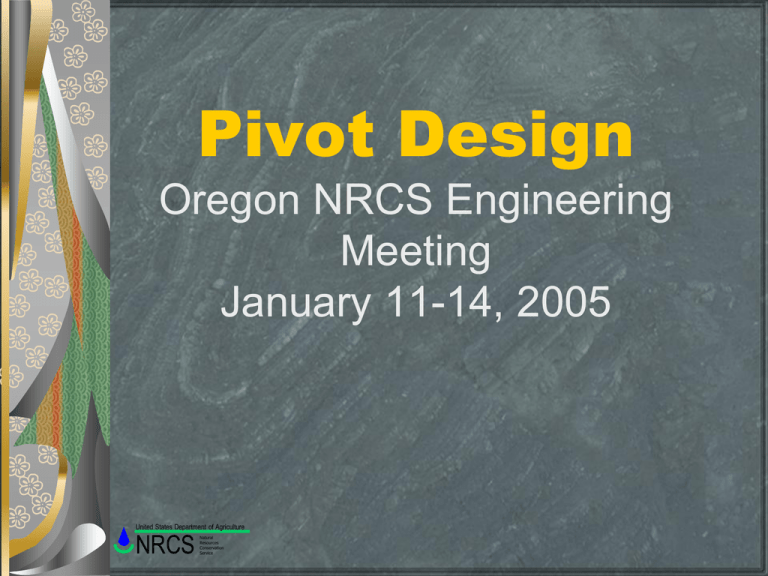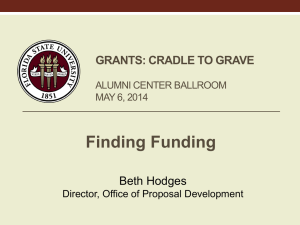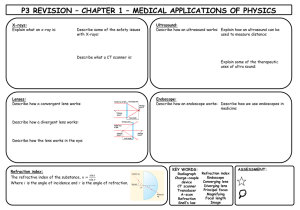Pivot Irrigation System Design
advertisement

Pivot Design Oregon NRCS Engineering Meeting January 11-14, 2005 United States Department of Agriculture NRCS Natural Resources Conservation Service Everything you need to know about Center Pivots, but didn’t really want to know Topics • • • • • • • Brief Overview Parts and Pieces Water requirements – System flow rate Pressure requirements – Friction loss Nozzle type – Selection Application – Rate, Timing Runoff management Who is Frank Zybach? • Inventor of the Center Pivot in the year 1951 First Pivot Valley - Model 1972 Hygromatic Raincat Olson Dowd Towable pivot Multi purpose Machines Parts and Pieces • • • • • • • Parts of a Pivot Physical Span Features Span Crop Clearance Overhang Length Tire Type and Drive Unit Slope Limitations Options Parts of the Pivot • • • • • • • • Pad Pivot point Pivot Span Add Span Transition Span Last Span Over Hang End Gun Pivot Pad Pivot Point Electric Collector Ring at Pivot Pivot Point with Stop Device Physical Span Features Pipe size Pipe Diameter 5”, 6”, 65/8”, 85/8”, 10” Overhang 4” and 5” The Tower The Span Span Type Span Length - depends on pipe size and Span type Number of Trusses - based on length Other consideration: Shorter spans- less weight on wheels - less rutting problems Smaller pipe less weight Slope Limitation • Allowable Slope – depends on profile (low, standard high), span length, pipe diameter, and tire size – range 7% to 18% • Crop clearance • Slope absorption • Pivot Flex Crop Clearance Slope Adsorption Tower -Span connection Joint Boot Span Alignment Alignment Switch Drop/Outlet Connections Span Crop Clearance • Four Profiles – Low profile 5.1 - 7.2’ depends on pipe size – Standard Profile 8.6 - 10.7’ – High profile 11.9 - 14.0’ – Ultra high profile 15’ High profile with sugar cane Overhangs Overhang Length • Depends some what on pipe size – 18.1 - 82.3 ft – And manufacture End Guns With Booster With out Booster Corner System Corner Guidance System Tire Type & Drive Units • Tire type – Standard, Retread, High float, Maxi float, Track, 11.2x38 • Drive Units – Standard 30 rpm – Optional 37 rpm – Hi Speed 56 rpm Large thin tires seem to be preferred Additional add ons Tire and Gear box Motor and Driveline Stop at the end Panels Remote control Options & Accessories • • • • • • • • • • • • • • • • • • • Pivot Flex Booster Transformer 45 amp package Drive unit fuse packages Automatic Reverse Pivot stop-in-slot Auxiliary control ( for controlling other electrical devices) Automatic end gun shutoff End gun override Remote panel mount End-of-field stop Low pressure shut-offs High voltage surge protection Phase loss protection Slow down timer Low voltage monitor Modified alignment Flow Meter Check Valve Options continued • • • • • • • • • • • • Automatic rain shut-off Severe duty gearboxes Heavy duty pivot Hydraulic system control High or low profile High speed motors Motor covers Traction rim Drops - steel, PVC, flexible hose Dry wheel track packages End guns Booster pumps Water requirements System flow rate What influences the System Flow rate? • • • • • • • • Area irrigated Crop requirement Climatic Conditions Soil type Terrain Efficiency Leaching, germination, pre-water, harvest Treat Pivot, end gun, and corner systems as separate Base Pivot flow rate 453Ad Q ft Q = flow rate (gpm) A = Area of pivot (ac) d = applied water (in/d) f = days between irrigation t = the fraction of time that the system is turned on for a typical day or L GIR AO Qb 2310 f t 360 2 Methods of determining area FULL CIRCLE WITH CORNER SYSTEM For Example if the Angle during full Corner Extension is 14.7 degrees, L = 1295 ft, R = 1636 ft and H = 2000 ft $ " a L R H . H L x H α 2 4 π R 2 90 AREA 43560 1295 x 2000 14.7 2 4 π 1636 2 90 AREA 43560 AREA 150.4 acres Depth to apply • Need to determine daily crop water • NRCS endorses four methods – Penman-Monteith – Radiation method – Temperature Method – Class A evaporation pan ET wetting adjustment factor Kf 1 2 3 5 7 10 Percentage of ET that is Transpiration Vegetables and Fruit 1.15 1.1 1.05 1.02 1 1 80 Row Crops 1.1 1.07 1.05 1.02 1 1 90 Small Grains 1.05 1.02 1 1 1 1 100 Forage Crops 1.05 1.02 1 1 1 1 100 Pasture 1.1 1.07 1.05 1.02 1 1 90 Vegetables and Fruit 1.2 1.15 1.1 1.05 1 1 70 Row Crops 1.15 1.1 1.07 1.05 1 1 80 Small Grains 1.05 1.02 1 1 1 1 95 Forage Crops 1.1 1.06 1.04 1.02 1.01 1 90 Pasture 1.2 1.15 1.1 1.05 1.03 1 80 Irrigation interval, f, days Crop Type During Peak Period For the Growing Season Water Losses from Pivots DROPLET EVAPORATION CANOPY EVAPORATION DRIFT RUNOFF CROP ROOT ZONE DEEP PERCOLATION Losses/Application efficiencies • Losses generally range between 5-20% • Most accepted range is 5-10% d or GIR value determined by ETc K f Pe Gross peak daily depth = %loss 1 100 t value • In design, t=0.90 is often used • For example t=0.9 would indicate that the system operates for 21.6 hrs out of every 24 hrs. or 3.6 days out of a 4 day cycle Total flow is calculated by Qtotal Qbase Qendgun Qcorner Example • A 1320 ft pivot with no end gun irrigating alfalfa with a Etc = 0.33in/d, t=0.9, Irrigation frequency 3 days • Find system flow rate Solution: From Kf table Kf =1.04 1320 .331.04 360 Qs 904gpm 2 23101 .9 360 Example 2 • Same pivot only operator wants to add a corner system with a radius of 180ft and a end gun with radius of 120ft • Find the system flow rate Etc = 0.33in/d, t=0.9, Irrigation frequency 3 days, 10% losses Qb L2 GIR AO 2310 f t 360 ETc K f Pe GIR %loss 1 100 Work Example .331.04 16202 1 10 360 100 Qs 1512gpm 23101 .9 360 Frequency • 2.5 days for sandier soils • 3.5 to 4.5 days for medium textured soils • Always use faction of a day System Pressure • • • • • • • Nozzle or base pressure Pressure regulators Boom back losses Friction Loss Elevation change of field Height of pivot Local losses (valves, elbows, screens, etc.) Base pressure • Use operating pressure of nozzle obtained from manufacture literature • If Pressure regulators are used, the base pressure of the regulator Pressure Regulators • Regulators have hysteresis • Regulators have friction losses • For design use 5psi over the threshold pressure Friction Loss • Calculate outlet to outlet or use multiple outlet factor. For Center pivot use 0.555 for Linear use 0.36 • Several friction equation may be used. HazenWilliams is most common 1.852 Q h f 10.5 C D 4.87 • Lh= equivalent hydraulic length Lh L Qs Qb Lh Friction Factors • Hazen-Williams c factors range 130-148 – Typical 140 • Material roughness for galvanized pipe – e= 0.006 inches • Use Swanee-Jain Equation to find f factor for Darcy-Weisbach Friction Loss with two pipe sizes Hf Hf smaller Hf I r smaller Hf I r larger • where: Hf = total pipe-friction loss along the combined lateral, ft (or m) Hf smaller = total pipe-friction loss along the lateral when comprised only of the smaller pipe (from Equation 4-4 using Hf per 100 for the smaller pipe), ft (or m) Hf I-r smaller = pipe-friction loss between the pivot inlet and radial distance r for the smaller pipe (from Equation 4-9 or Figure 4-1 or Table 4-2 using Hf small), ft (or m) Hf I-r larger = pipe-friction loss between the pivot inlet and radial distance r for the larger pipe (from Equation 4-9 or Figure 4-1 or Table 4-2 using Hf large), ft (or m) r = distance from center pivot inlet to where the transition from large pipe to small pipe occurs, ft (or m) Simplified Method Hf Kdual Hf smaller K dual D 1 smaller Dl arg er 4.87 3 5 15 r r r 2 1 1 3 Lh 5 Lh 8 Lh Hf Hf smaller Hf Ir2 smaller Hf Ir2 medium Hf Ir1 medium Hf Ir1 larger More than two pipes H f H f smaller H f I r2 smaller H f I r2 medium H f I r1 medium H f I r1 larger 8200 8100 8000 7900 7800 7700 7600 7500 7400 7300 7200 7100 7000 98 105 5200 6900 6000 107 106 103 101 6800 6800 6700 8200 8100 8000 7900 7800 7700 7600 7500 7400 7300 7200 7100 7000 6900 6200 104 102 100 99 6700 Topography 6200 6100 6100 6000 5900 5900 5800 5800 5700 5700 5600 5600 5500 5500 5400 5400 99 5300 5300 5200 Elevation Required Pressure at Pivot point Pressure at pivot point = Pnoz + Preg + 0.43(Hfbb + Hf+ ΔElf + Elp+ hflocal ) Example • Given: – 1400ft pivot –8” pipe – Qb=1200 gpm - Qg=120gpm – Nozzle operating pressure 20-30 psi – 25psi regulators- Nozzle height 6’ – ΔZ for field 50’ –local losses 5psi • Find: Required pressure at pivot point Solution 1320 Lh 1400 1468 1200 1.852 1320 H f 10.5 140 7.7554.871468 45.74 Ppp 25 5 5 .43 45.74 50 6 79 psi End Guns • Effects on – Pressure – Flow – Pump selection Flat curve Sprinkler Nozzles Distribution Patterns, Nozzle Spacing and Height. • Pivot system (Heermann-Hein) or Linear (Christensen) CU shall not be less than 85% (76% DU), except as noted in criteria for a Low Energy Precision Application (LEPA) system. Selecting Nozzle Packages • • • • Pressure requirements Wetted diameter Drop size Peak application rates Sprinkler Discharge • Sprinklers are sized using the following equation r - distance from pivot Sr – sprinkler spacing 2rS r qr 2 Qb L Sprinkler spacing • Rule of Thumb – W/2 Sr W/4 • W is the wetted diameter of the sprinkler • From a point midway between the first and second tower to the distal end of a center pivot, spray nozzle spacing along lateral lines shall not exceed 25% of the effective wetted diameter and impact sprinkler spacing shall not exceed 50 percent of the effective wetted diameter Height above the Ground • New terms – – – – LEPA LESA LPIC MESA Effects of height Low pressure Low drift – 6, 10, 15 psi end pressure – Small atomized droplets are practically eliminated thus reducing evaporation – Mainly spinner and spray types – Placement height 3, 6, 9, 12 foot – outlet spacing 30, 80, 90, 108 inches • High application rates - Not good for heavy soils or steeper slopes Sprays Low Pressure LEPA Bubblers Irrigation Mode Chemigation Mode Small Droplet - High Uniformity – 15 to 25 psi end pressure – Droplets size can be adjusted with different pads • fine droplets for heavy, flat soils and delicate crops where wind drift is minimal, or • large droplets with good wind resistance for coarse soils – Iwob, Spinners, some sprays • Medium on application rate, wind fighting, and drop energy Wobbler - Iwob Spinner - Nutator Large Droplet – High Uniformity – 15 to 25 psi end pressure – Droplets size can be adjusted with different pads • Larger droplets further throw • Good wind fighting – Rotators • Lower application rate, higher drop energy, and stream energy, may cause surface sealing Rotator Style • Low pressure impact – 25 to 35 psi end pressure – equal size nozzles spaced progressively closer 27, 18, and 9’ – saves energy, controls drift, increases efficiency – On lighter soils where adequate pressure is not available for high pressure or where spray nozzles would cause excessive runoff • Intermediate spaced impacts – 50 to 55 psi end pressure – High and low angle sprinklers – spaced progressively closer 27,18, and 9’ – on heavy soils and severe slopes where the system is used for supplemental irrigation • Variable Spaced Impacts – 50 to 55psi end pressure – smaller high and low angle sprinklers – nearly equal size, spaced progressively closer – On soils where the system is required to have maximum uniformity and rolling terrain with low intake rates, on rolling terrain where runoff could be a problem. Distribution Pads • Smooth Spray Pads – smallest droplet – minimum soil disturbance or soil compaction – infiltrates best on heavy soil – susceptible to wind and evaporation – 6 - 25 psi • Medium Groove Spray Pads – larger drops, slightly wider spray pattern – minimizes wind drift – still infiltrates moderately heavy soils – General propose average conditions and pressure – less than 40 psi • Deep Grooved Spray Pads – large droplets in small direct streams – greatest wind resistance reduces evaporation – unsuitable for sensitive crops and light soils where water does not move laterally – uniformity reduced under calm conditions – pressures above 15 psi Pad configurations • Available in – flat – concave – convex Pad style Application • Rates shall be selected such that runoff, translocation, and unplanned deep percolation are minimized Water Applied • Just how much water are You putting on? – hours/revolution at 100% = (.105) (DLRDU) Speed – DLRDU = Distance from Pivot to last regular drive unit (feet) – Speed = Travel speed of Last Regular Drive Unit at 100% – Applic.rate = _____________(GPM )x (735.3)_________ (Sys Length to last twr+O/H length+E.G.RAD)2 – In./rev @100% = (Hrs./Rev.@100%) x (In./Day) 24 Application Rates & Application – Instantaneous – Average – Total Application RATES WATER APPLICATION RATE RATES, inches / hour 4.0 3.5 PEAK APPLICATION RATE 3.0 2.5 2.0 1.5 1.0 0.5 0.0 0.0 0.2 TIME OF WETTING 0.4 0.6 0.8 TIME, hours 1.0 Impact Sprinkler Pattern Instantaneous Application Rate where water is hitting the ground Area being watered: Average Application Rate 0.25 0.2 0.15 0.1 0.05 Distance from Nozzle (ft) 51 48 44 41 38 34 31 28 25 21 18 15 11 8 5 0 2 Application Rate (inches/hour) Impact Sprinkler: Pattern Profile of Average Application Rate Total Application for a Single Impact Sprinkler Total Application = Average Rate x Run Time • IF – Nozzle q = 5 gpm – Nozzle throw = 45 ft • THEN – The average application rate over the area to which water is applied (the green circle) is 0.076 inches/hour (if all the water makes it to the ground) • AND SO – If the sprinkler is run for 10 hours TOTAL APPLICATION is 0.76 inches Pivot & Linear-move Application Devices Instantaneous Application Rate Depends on Where The Evaluation Point is Serrated Deflection Plate Instantaneous Application Rate Flat Deflection Plate Nozzle Water hitting ground in most of outside part of area Application Devices with Distinct Stream Exaggerated Rotator-style Pattern w/ 4 individual streams Instantaneous Application Rate Where water is Hitting the ground Area of Average Application Rate Pattern Profile Illustrations Total Application for a Single Applicator Total Application = Average Rate x Run Time • IF – Nozzle q = 5 gpm – Nozzle throw = 25 ft • THEN – The average application rate is 0.245 inches/hour • AND SO – If the sprinkler is run for 10 hours TOTAL APPLICATION is 2.45 inches (if all the water makes it to the ground) Consider Overlap & Sprinkler Movement • Individual Patterns are Overlapped for Uniformity – Typical hand/wheel line spacing of 40’ (& 50’ or 60’ in solid sets) – Adjacent applicators on a pivot/linear-move • Consider the movement of the pattern as the pivot/linear-move advances – the instantaneous application rate the soil “sees” will change because the overlapped pattern is not perfectly uniform – Initially the soil “sees” a small rate, gradually getting more intense until it peaks, then gradually decreases again as the machine moves away Application Rate Instantaneous Application Rate Varies as Machine Moves over the field Wetted Diameter Soil One point in the field Application Rate Summary • Instantaneous Application Rate is the rate “seen” by the soil at one point in the field at one point in time – NOT influenced by speed of machine • Average Application Rate is the average rate “seen” by the soil at one point in the field over the time it receives water– NOT influenced by speed of machine • Total Application is total “depth” of water received by the soil in the field. Equal average rate x time watered Methods of calculating True only for elliptically shaped application patterns Newer nozzles • • • • Ra=0.26 *Q*Xp/W r= Rp/Ra, (1<r<2) M=qn√P W=a(HcM)b Ra = average application rate Rp= peak application rate qn =nozzle flow P = nozzle pressure H = mounting height W = pattern width a, b, c, are empirical coefficients determined for each spray device type Reference • “Application Rates from Center Pivot Irrigation with Current Sprinkler Types”. by Dennis Kincaid • http://asae.frymulti.com/request.asp?JI D=8&AID=17585&CID=smppnr&T=1 Soil Sprinkler Interaction • Why is the application rate a concern? Infiltration Rate Varies With Time 5.0 INFILTRATION RATE, (in/hr) Initial Rate is high 4.0 3.0 Sandy soil Rate Drops Rapidly 2.0 Silty soil 1.0 0.0 0 12 24 36 INFILTRATION TIME, (minutes) 48 60 Application vs. Infiltration = Runoff ? • There is potential for runoff when Application Rate exceeds Infiltration Rate. • Runoff will occur if “surface storage” cannot temporarily hold the water not being infiltrated. P e a k W a t e r A p p l i c a t i o n R a t e = 2 . 7 i n c h e s / h o u r 5 . 0 W a t e r A p p l i c a t i o n = 1 . 0 i n c h S y s t e m F l o w R a t e = 8 0 0 g p m S y s t e m L e n g t h = 1 3 4 0 f e e t 4 . 0 5 5 f o o t W e t t e d D i a m e t e r 3 . 0 4 . 0 3 . 0 2 7 % P o t e n t i a l R u n o f f 2 . 0 5 . 0 2 . 0 1 . 0 1 . 0 INFLTRAIONRATE,(in/hr) APLICATIONRATE,(in/hr) 0 . 3 N R C S I n t a k e F a m i l y C u r v e 0 . 0 0 0 . 0 1 2 2 4 3 6 4 8 W A T E R A P P L I C A T I O N T I M E , ( m i n u t e s ) 6 0 Runoff Potential 0.3 Intake Family Curve INFILTRATION RATE, (in/hr) 5.0 4.0 3.0 Instantaneous App rate “seen” by soil 2.0 Potential Runoff 1.0 Surface Storage 0.0 0 12 24 36 48 INFILTRATION TIME, (minutes) 60 FACTORS AFFECTING RUNOFF 1. SYSTEM CAPACITY - GALLONS/MINUTE PER ACRE 780 GPM / 130 ACRES = 6 GPM/ACRE 2. DEPTH OF APPLICATION PER REVOLUTION - INCHES 3. SPRINKLER PACKAGE - SPRAY, IMPACT, LEPA 4. SOIL SURFACE CONDITIONS AMOUNT OF WATER THE SOIL SURFACE WILL HOLD PEAK APPLICATION RATE, IN/HR EFFECT OF CAPACITY ON PEAK APPLICATION RATE 8 1300 ft from pivot 7 WETTED DIAMETER: 20 ft 6 5 40 ft 4 3 60 ft 2 100 ft 1 0 120 ft 0 1 2 3 4 5 6 7 SYSTEM CAPACITY, gpm / acre 8 Water Application Rate (in/hr) Application Rates by Sprinkler Type 8.0 7.0 6.0 5.0 4.0 3.0 2.0 1.0 0.0 Low Pressure Spray Rotating Spray Sand Low Pressure Impact Silt High Pressure Impact 0 12 24 36 48 60 72 Water Application Time (min) APPLICATION RATE, inches/hour Rate also varies along machine 1300 feet 3 975 feet 2 1 650 feet 0 0 0.2 0.4 0.6 TIME OF APPLICATION, hours 0.8 1.0 EFFECT OF APPLICATION DEPTH ON RUNOFF RATES, inches / hour 4.0 3.5 1.0 SCS INTAKE SOIL 3.0 2.5 2.0 1.5 1.0 0.8 in 1.2 in 2.4 in APPLICATION DEPTH 0.5 0.0 0.0 1.6 in 0.2 0.4 0.6 0.8 TIME, hr 1.0 1.2 1.4 SURFACE STORAGE SOIL DEPRESSIONS STORE WATER HOW TO REDUCE RUNOFF? 1. REDUCE SYSTEM CAPACITY - irrigate more hours per year - increase chances of getting behind 2. REDUCE APPLICATION DEPTH – make more revolutions per year 3. CHANGE SPRINKLER PACKAGE – increase wetted radius • may need higher pressure • make changes to pump Offset Nozzles Boom backs Booms Behind Towers Effects of Booms Booms: Reduction of Peak Application Rate Boom Offset from Pipe Zig-Zag Configuration Reduction* (%) 10 ft 5 – 15% 15 ft 15 – 30% 20 ft 30 – 40% 4. INCREASE SURFACE STORAGE – extra tillage, fuel, time, weed control - Methods of increasing Surface Storage • • • • • • Basin Tillage Dammer-diker Subsoiler Field cultivator Rough cloddy ground (slope dependent) Organic residue Dammer-Diker Ways to analyze Runoff • Field test • CPnozzle • Guess? Conditions that May Produce Surface Sealing • Salts – Sodium tends to break down structure and produce “dispersed” conditions which lead to reduced infiltration rates – Calcium tends to bind particles together, improving soil structure and, thus, infiltration rates – These impacts typically seen in soils with large percentages of clay particles • Compaction/Sealing – By Equipment – By impact of water particles with soil • Intense rainstorm • Application Rate & Energy of Sprinkler Droplet; energy is basically a function of size of droplet • Silty soils more susceptible; aggregates broken down and the silt particles “float” on top, producing a seal • Effect is progressive, getting worse throughout the irrigation season – Organic or other material added to soil surface Sealing Effect on Infiltration Rate INFILTRATION RATE, (in/hr) 5.0 4.0 3.0 2.0 Soil before sealing 1.0 Soil after sealing 0.0 0 12 24 36 INFILTRATION TIME, (minutes) 48 60 Special Application • Fertilizer application • Pesticide application • Waste Water Application Linears or Laterals • Require Guidance system • Limited by water source • Harder to match frequency with crop and field limitations • More problems with runoff • More expensive LEPA with Sock Question? Thanks Electrical • Electrical design of a system is dependent on a number of factors . These include length of system, number of drive units, options (hispeed and or booster pump) and voltage available at the pivot. • Electrically driven components (motors) require a certain quantity of electricity called Amps and the electricity must be a certain pressure (Volts) much the same as the hydraulic supply to a system. • Several things are needed for the electrical design of a Pivot – amp load – voltage drop with given wire size – voltage supply at the pivot and end tower voltage requirement • System amperage is based on electrical load of the system, i.e., number of drive motors, hi speed, booster pumps, etc. Example • Given: – Length - 5 spans X160 ft + 36ft overhang – High speed • 3 drive units high speed, 2 drive units standard – No booster pump – Helical gear center drive motors • Solution: – Amp Load = (1.8*A*0.85) + (1.1*B*0.60) +2.25 • 6.63 amps Determining System Voltage Drop • Voltage drop for the system is calculated to insure a minimum of 440 volts on pivots at the last drive unit – 440 + system voltage drop = Minimum pivot supply voltage Example • Given: High speed model with 2Hp booster pump, 180’ spans (1260’), 3 standard speed drive units, 4 high speed drive units, and a 13.7 amp load. • Solution: from graph #2 for 12ga. wire voltage drop = 30 volts 440+30 = 470 volts at pivot Probably need some 10ga wire to be safe • How about voltage drop from Transformer out to the pivot point





